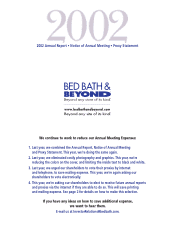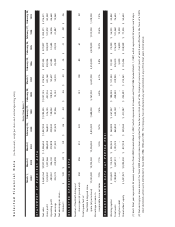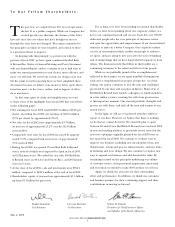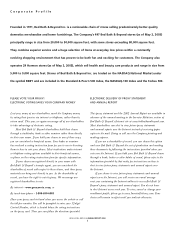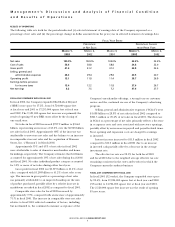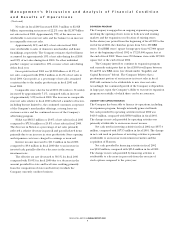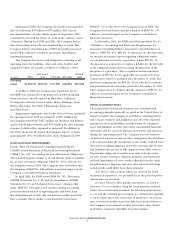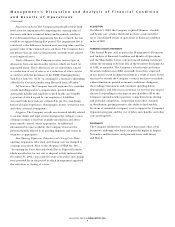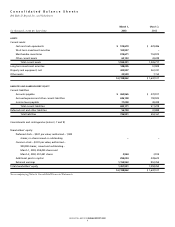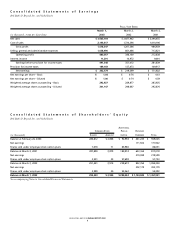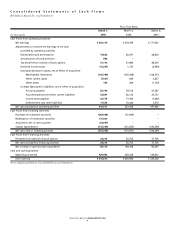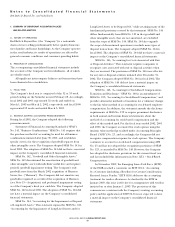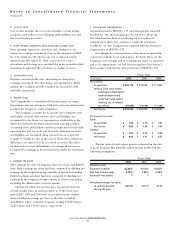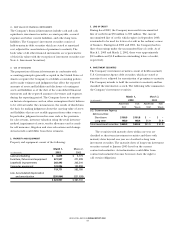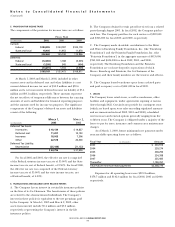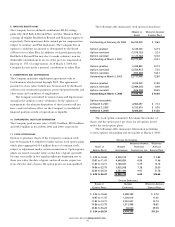Bed, Bath and Beyond 2002 Annual Report Download - page 7
Download and view the complete annual report
Please find page 7 of the 2002 Bed, Bath and Beyond annual report below. You can navigate through the pages in the report by either clicking on the pages listed below, or by using the keyword search tool below to find specific information within the annual report.
BED BATH & BEYOND ANNUAL REPORT 2002
5
During fiscal 2002, the Company increased its uncommitted
line of credit from $50 million to $75 million. The current
uncommitted line of credit, which expires in September 2003,
is intended to be used for letters of credit in the ordinary course
of business. During fiscal 2002 and 2001, the Company had no
direct borrowings under the uncommitted line of credit. The
Company believes that during fiscal 2003, internally generated
funds will be sufficient to fund its operations, including its
expansion program.
The Company has contractual obligations consisting of all
operating leases for buildings, office and other facilities and
equipment which are payable as follows as of March 1, 2003:
LESS THAN 1AFTER 5
(in 000’s) TOTAL YEAR 1-3 YEARS 4-5 YEARS YEARS
Operating
Leases $2,358,770 $230,974 $711,956 $442,894 $972,946
As of May 2, 2003, the Company has leased sites for 60
new BBB stores planned for opening in fiscal 2003, including
seven new stores already opened in Mira Mesa, California;
St. Augustine, Florida; Coeur d’Alene, Idaho; Dubuque, Iowa;
Wilton (Saratoga), New York; Chattanooga, Tennessee;
and Tyler, Texas.
Approximate aggregate costs for the 60 leased stores planned
for opening in fiscal 2003 are estimated at $79.4 million for
merchandise inventories, $32.5 million for furniture and fixtures
and leasehold improvements and $10.9 million for store opening
expenses (which will be expensed as incurred). In addition to
the 60 locations already leased, the Company expects to open
approximately 20 to 30 additional locations during fiscal 2003.
RECENT ACCOUNTING PRONOUNCEMENTS
In June 2001, the Financial Accounting Standards Board
(“FASB”) issued Statement of Financial Accounting Standards
(“SFAS”) No. 143, “Accounting for Asset Retirement Obligations.”
The standard requires entities to record the fair value of a liability
for an asset retirement obligation. SFAS No. 143 is effective for
the Company in fiscal 2003. The Company does not believe that
the adoption of SFAS No. 143 will have a material impact on the
Company’s consolidated financial statements.
In April 2002, the FASB issued SFAS No. 145, “Rescission
of FASB Statements No. 4, 44, and 64, Amendment of FASB
Statement No. 13, and Technical Corrections.” Among other
items, SFAS No. 145 updates and clarifies existing accounting
pronouncements related to reporting gains and losses from
the extinguishment of debt and certain lease modifications that
have economic effects similar to sale-leaseback transactions.
SFAS No. 145 is effective for the Company in fiscal 2003. The
Company does not believe that the adoption of SFAS No. 145
will have a material impact on the Company’s consolidated
financial statements.
In November 2002, the FASB issued Interpretation No. 45,
“Guarantor’s Accounting and Disclosure Requirements for
Guarantees Including Indirect Guarantees of Indebtedness of
Others” (“FIN No. 45”). FIN No. 45 elaborates on the disclosures
for interim and annual reports regarding obligations under
certain guarantees issued by a guarantor. Under FIN No. 45,
the guarantor is required to recognize a liability for the fair value
of the obligation undertaken in issuing the guarantee at the
inception of a guarantee. The recognition and measurement
provisions of FIN No. 45 are applicable on a prospective basis
to guarantees issued or modified after December 31, 2002. The
disclosure requirements for FIN No. 45 are effective for interim
and annual financial statements issued after December 15, 2002.
The Company does not believe that the adoption of FIN No. 45
will have a material impact on the Company’s consolidated
financial statements.
CRITICAL ACCOUNTING POLICIES
The preparation of financial statements in conformity with
accounting principles generally accepted in the United States of
America requires the Company to establish accounting policies
and to make estimates and judgments that affect the reported
amounts of assets and liabilities and disclosure of contingent
assets and liabilities as of the date of the consolidated financial
statements and the reported amounts of revenues and expenses
during the reporting period. The Company bases its estimates
on historical experience and on other assumptions that it believes
to be relevant under the circumstances, the results of which form
the basis for making judgments about the carrying value of assets
and liabilities that are not readily apparent from other sources.
In particular, judgment is used in areas such as the provision
for sales returns, inventory valuation using the retail inventory
method, impairment of assets, vendor allowances and accruals
for self insurance, litigation and store relocations and closings.
Actual results could differ from these estimates.
Sales Returns: Sales returns, which are reserved for based
on historical experience, are provided for in the period that the
related sales are recorded.
Inventory Valuation: Merchandise inventories are stated at
the lower of cost or market, using the retail inventory method.
Under the retail inventory method, the valuation of inventories
at cost and the resulting gross margins are calculated by applying
a cost-to-retail ratio to the retail value of inventories. At any one
time, inventories include items that have been marked down to
the Company’s best estimate of their fair market value. Actual
markdowns required could differ from this estimate.

